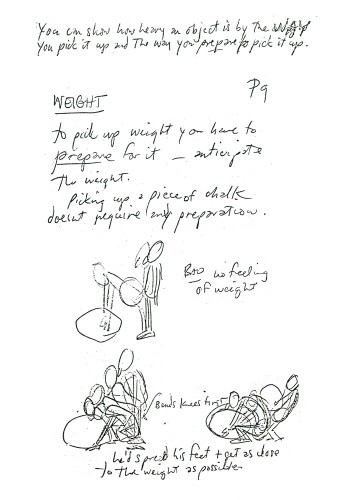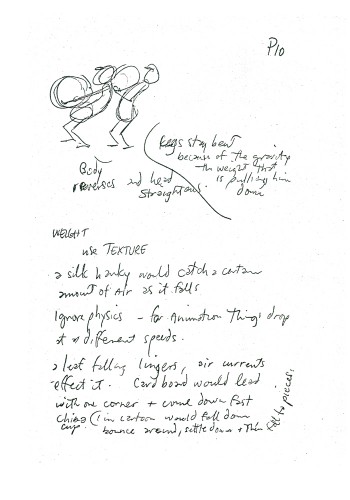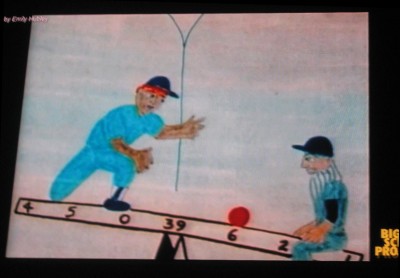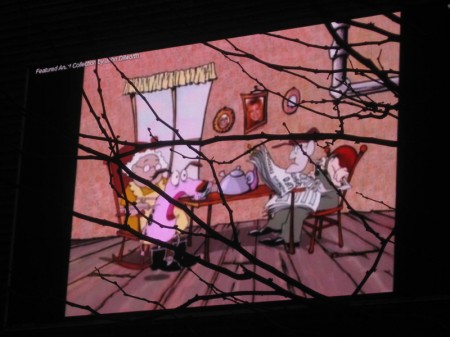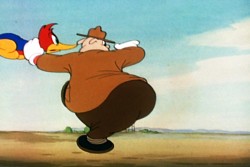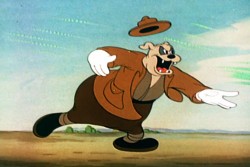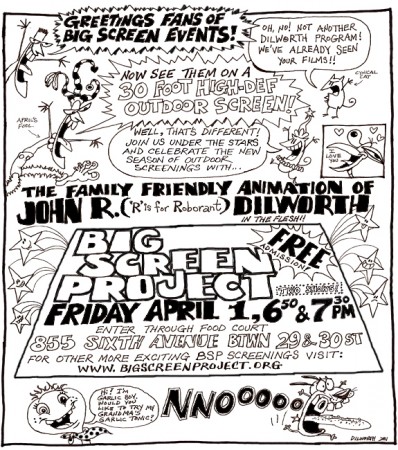Category ArchiveCommentary
Commentary 14 May 2011 06:58 am
Left overs
 - Anthony Lane has written an expressive and interesting piece for The New Yorker Magazine. I felt the article about Pixar intelligent and well-worth reading. Perhaps the fact that I haven’t visited the Emeryville factory, made the piece informative and amusing to me. This is something written for the general public.
- Anthony Lane has written an expressive and interesting piece for The New Yorker Magazine. I felt the article about Pixar intelligent and well-worth reading. Perhaps the fact that I haven’t visited the Emeryville factory, made the piece informative and amusing to me. This is something written for the general public.
I was first informed of the story by George Griffin who wrote: You might want to read the Anthony Lane article on Pixar in this week’s New Yorker. “It’s from a bemused outsider POV, a bit condescending, yet often witty and even insightful. It reminded me of why I distrust the emotional core of the brand: just change the eyebrows and voila!”
No sooner had I received that email, when I’d found that Amid Amidi had already written not one but two nasty bits about it on Cartoon Brew here and here. He calls the article “fawning” and says it, “. . . has convinced me that it is next to impossible to write anything of substance about the studio at this time.”
Perhaps Amid read a different article than I have or perhaps he’s written often enough about the studio (2 books on the market so far) that he just doesn’t have more to say. That is, unless he goes negative which Lane isn’t trying to do.
Anthony Lane has a distinct style in all his writing, and it rises to the top in this article. That style carries the article, at least, for the first half. Like his best movie reviews it’s not the deepest thinking, though there are some good observations I would’ve missed had I not read it. (Yet, how many reviewers these days are deep thinkers. You might find a handful if you work hard at it. Gone are the days when Pauline Kael would argue with Andrew Sarris in their columns over philosophical differences about a movie. Today it’s all thumbs up or down and five Rotten Tomatoes out of ten.)
The piece for the New Yorker was intended as a puff piece, and it delivered. Those, like I, who are not completely sold on Pixar’s eternal genius would hope for more, but I accept the article for what it was and enjoyed it as such.
Rather than take anyone’s word for it, I suggest you try to read the article yourself. It’s not on-line (unless you have a subscription to The New Yorker) but can be found on newstands or in libraries or in friends’ hands. The search is worth the read, despite the snarky reviews of it on line.
- Speaking of Pixar, the Vancouver based school, VanArts is holding a Pixar Artists’ Masterclass in Animation and Story Development. Matthew Luhn (Head of Story) and Andrew Gordon (Animator), both from Pixar Animation Studios, will be the instructors. The program will travel to several cities – with two days in New York, June 24th and June 25th. Geared for professionals and students alike, the classes are now 60% sold out, but have some availability if you’re interested.
Check it out.
Through an email comment sent me by Mike Peraza, I went to his blog, The Ink and Paint Club, and found it quite interesting. There’s a particlularly good piece about Don Griffith, nestled in some older position a few pages back; there is also a three-post-piece about The Black Cauldron that’s worth a read. You’ll find plenty of bits like this:
- As Cauldron was screened for the new management, Jeffrey Katzenberg proceeded to ask for “… cover shots” during sweat box meetings not fully understanding that extra shots to “cover” a scene was only done in live action. In animation, we DREW each shot as they were needed depending directly on the story board/workbook. Multiple animated variations would have made the already expensive process out of financial reach even for Disney.
Scrolling through the blog, if you’re a Disney fan, you’ll find something that appeals to you. Take a look.
I’ve added the site to my “blog roll” to the right.
- Jake Friedman has a big article on Art Babbitt’s involvment with animation education going all the way back from the Disney golden age right through to his lectures at Dick Williams’ studio. The piece can be found at AWN.
This reminds me that I’ve meant to run some more of the Williams notes on the lectures. It eventually became Dick’s book, The Animators’ Survival Kit, but there’s something innocent about the rough quality of those notes. I’ll post more of them soon.
Commentary &Photos 08 May 2011 08:05 am
Creepers – PhotoSundayRecap
For today’s PhotoSunday, I’m recapping something posted back in July of 2008. This is one of many I did back then in which I took some pride. I’ll have to get back to photographing my streets of NY. Now that the weather is warming up a bit, I’ve every encouragement to do so.
- There was an excellent documentary on PBS this past Thursday. It was called, “Home.” Perhaps it was just local channel 13/WNET that aired it. The show was a documentary about New York from the vantage point of outsiders who’d moved here. The director, Alan Cooke, interviewed lots of celebrity types; Frank McCourt, Liam Neeson, Alfred Molina, Rosie Perez, Mike Myers, Colin Quinn, Susan Sarandon and Woody Allen offered choice comments throughout the show.
Malachy McCourt, at one point, said that the City was cold and difficult. Even the sidewalks were cold, hard concrete. Yet in these sidewalks there were always cracks with bits of life shooting up from the least likely places.
Wall-E offers a world of no vegetation, and we have to accept that premise. Yet, reality shows us that nothing can cede the bits of green from stopping in the coldest of extreme. George Carlin once said that styrofoam was not going to destroy life on earth. It was just going to stop HUMAN life on earth. He speculated that perhaps humans were put here specifically to invent styrofoam so that the earth could continue after all humans died off using styrofoam for whatever it needed. Even the devestated Hiroshima and Nagasaki have already recovered from the nuclear onslaught some sixty years ago. Grass grows there.
Here are bits of grass, life and plants creeping out from the least likely places.

(Click any image to enlarge.)______________
To me, it’s more likely that 700 years after the humans left earth,
the planet would have looked more like the photos below.
Commentary &Puppet Animation 07 May 2011 07:01 am
Left Overs
- There should be plenty of 3D stop-motion films circling the globe ni a year or two. Recently there’s been a bit of news about a few of these animated features.
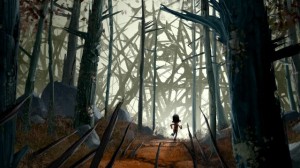 LAIKA, the company that produced Coraline, under the sturdy direction of Henry Selick, has announced a new two picture deal with Focus Features. Their first film, ParaNorman, will be released on August 17th, 2012. The second, yet-to-be-named, picture will be released nationwide in 2014. The first film is being directed by Sam Fell and Chris Butler, from his own original screenplay. Sam Fell was director of The Tale of Despereaux and Flushed Away. Chris Butler was storyboard supervisor on Coraline and storyboard artist on Tim Burton’s Corpse Bride. The voice cast includes Academy Award nominee Casey Affleck (The Assassination of Jesse James by the Coward Robert Ford), Tempestt Bledsoe (The Cosby Show), Jeff Garlin (Curb Your Enthusiasm), John Goodman (Monsters, Inc.), Anna Kendrick (Up in the Air), Leslie Mann (The 40-Year-Old Virgiin), and Tony and Emmy Award winner Elaine Stritch (30 Rock).
LAIKA, the company that produced Coraline, under the sturdy direction of Henry Selick, has announced a new two picture deal with Focus Features. Their first film, ParaNorman, will be released on August 17th, 2012. The second, yet-to-be-named, picture will be released nationwide in 2014. The first film is being directed by Sam Fell and Chris Butler, from his own original screenplay. Sam Fell was director of The Tale of Despereaux and Flushed Away. Chris Butler was storyboard supervisor on Coraline and storyboard artist on Tim Burton’s Corpse Bride. The voice cast includes Academy Award nominee Casey Affleck (The Assassination of Jesse James by the Coward Robert Ford), Tempestt Bledsoe (The Cosby Show), Jeff Garlin (Curb Your Enthusiasm), John Goodman (Monsters, Inc.), Anna Kendrick (Up in the Air), Leslie Mann (The 40-Year-Old Virgiin), and Tony and Emmy Award winner Elaine Stritch (30 Rock).
Meanwhile . . .
Aardman animation is producing two features in conjunction with Sony Pictures Animation. Arthur Christmas, is a 3D adventure that will hit theaters on November 23, 2011. The voice cast includes: James McAvoy, Hugh Laurie, Jim Broadbent, Bill Nighy, Imelda Staunton, and Ashley Jensen, which is currently in production. The film is being directed by Sarah Smith from a screenplay written by herself and Peter Baynham.
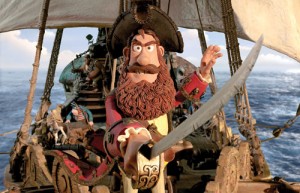 The second feature, The Pirates! In An Adventure with Scientists will be directed by Peter Lord and co-directed by Jeff Newitt. The screenplay is by Gideon Defoe, based upon his books. The vocal cast will include: Hugh Grant, David Tennant, Imelda Staunton, Jeremy Piven, Salma Hayek, Brian Blessed, and Brendan Gleeson.
The second feature, The Pirates! In An Adventure with Scientists will be directed by Peter Lord and co-directed by Jeff Newitt. The screenplay is by Gideon Defoe, based upon his books. The vocal cast will include: Hugh Grant, David Tennant, Imelda Staunton, Jeremy Piven, Salma Hayek, Brian Blessed, and Brendan Gleeson.
And . . .
Henry Selick has recently signed to direct features for Disney/Pixar. He’ll be working out of Pixar’s Emeryville, Calif. campus and using their resources. The films he will make will be written and directed by him based on both original ideas and literary properties. This brings Selick back to many of the classmates with whom he graduated from CalArts.
- Last week the ASIFA East Festival was held and awards were presented to the chosen filmmakers. Cartoon Brew posted a note about the winners and included a snarky comment by Amid Amidi which takes a swipe at the board members for entering their films in this local festival. And I do mean local festival. Here’s Amid’s comment:
- ASIFA-East president David Levy also won two of the top awards: Best Educational Film and 1st Place for Independent Film. He’s a nice guy so let’s all look the other way and pretend that’s not a conflict of interest…
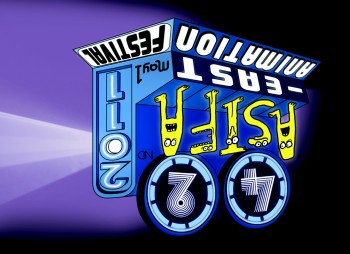 The quality of the film is irrelevant. Doesn’t matter if it’s the best animated short since One Froggy Evening. If the ASIFA-East leadership or board is competing against its members, that’s a serious issue that affects the legitimacy of the awards.
The quality of the film is irrelevant. Doesn’t matter if it’s the best animated short since One Froggy Evening. If the ASIFA-East leadership or board is competing against its members, that’s a serious issue that affects the legitimacy of the awards.
Here’s a response from Adrian Urquidez:
- ASIFA-East board members have always been allowed to participate in the festival and always will because the volunteer board is comprised of active members in the animation community both in their professional and personal lives. In no way are any of the awards just “given to people in their circleâ€, they are voted on by the hundreds of members who participate in the well-publicized jury screenings. We’ve had 42 years of successful festivals, and while always looking to improve, I believe we have a lot to be proud of
If one wants to have a discussion on outreach, fine. But unnecessary slander gets you nowhere.
-Adrian Urquidez ASIFA-East website manager, board member and (horror of horrors) grateful award winner.
The way ASIFA East works is this. Filmmakers are asked to submit films; board members are not discouraged. There are several nights of viewing for any member who wants to attend. Those who attend are the voters for any awards.
Just as the Oscar voters are tied to some of those entering the awards and vote for their friends, those who attend the ASIFA screenings are probably friends of some of the filmmakers and will most likely vote for their friends. This is human nature, not corruption.
This doesn’t mean that it’s a small coterie of friends who always win the awards. However, when only a small number of films are entered, the quality will be lower than usual. If board members (all 9 of them) weren’t allowed to enter their films, there would be fewer board members since they do a lot of work for no pay, and if they weren’t allowed to enter the films in the festival there would be a reason for them not to volunteer to be on the board and do all the hard, necessary work.
This is very different from the awards given out of ASIFA Hollywood. ASIFA East is a small group in New York and should be reccognized as such. When The Lipsett Diaries won the award as the Best Canadian Film at the Ottawa Animation Festival, was that suspect? Somehow I, personally, didn’t see it that way. I did see a good film win a well-deserved award. Just as I saw David Levy’s film win a deserved award.
In the past 40 years or so of ASIFA East’s festivals, I can assure you I’ve won quite a few awards, despite the fact that I’ve been a board member. Certainly all my licking of stamps for the ASIFA mailers wasn’t enough to make my films succcessful with all the voters who didn’t know me. My films won the awards, and I was pleased to be able to share them with the audience – that’s truly the prize you get. (When you win a prize, your film is usually screened in the large New School auditorium.) The awards – a piece of paper – are worthless. Hearing a large audience (about 1000) makes the win worth while and something to remember.
Commentary &SpornFilms 28 Apr 2011 07:28 am
Ends and Odds
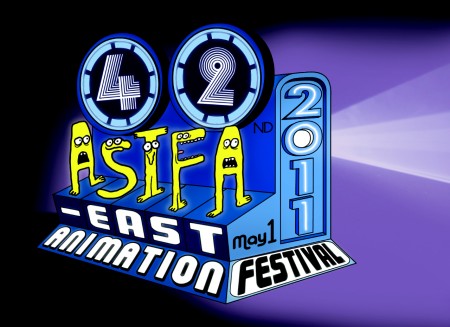
The ASIFA East Animation Festival will be held on this coming Sunday, May 1st.
Tishman Auditorium, The New School. 66 West 12th Street.
As always, admission is free. So is the party after the show.
________________________
- We just received the poster for our upcoming half-hour program for HBO, I CAN BE PRESIDENT. The show will air, for the first time, on June 22nd and will be repeated ad infinitum after that. HBO is throwing a party for it on May 26th; I’ll take some pics, if anything interesting happens, and post them.
The poster is a mishmash of part of a scene from the show with other elements thrown at it. The type is less than I would have liked. I have difficulty with the mix of translucent and opaque colors (something I would never do), so I asked them to put a white border around it. The poster originally bled from the page. Hopefully, this takes a bit of the onus off it. Hey, what do I have to complain about! They made a poster!
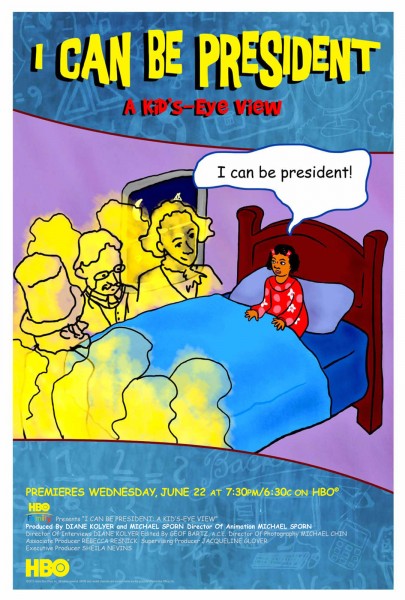
The poster for our show, I CAN BE PRESIDENT
Key to this show was the work of animators Matt Clinton and Katrina Gregorius. They both had a big hand in making anything that is “Special” in the show Special.
- As part of the Tribeca Film Festival, Saturday at 7:00pm there will be a NYWIFT “Independent Women” screening and panel.
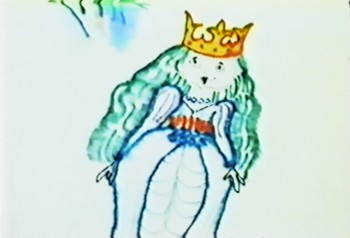 The films to be screened include:
The films to be screened include:
Pastorale (1950, dir. Mary Ellen Bute),
Divination (1964, dir. Storm de Hirsch),
Windy Day (1967, dir. Faith Hubley),
Zenscapes (1969, dir. Marie Menken),
Anything You Want to Be (1971, dir. Liane Brandon),
Homage to Magritte (1974, dir. Anita Thacher),
1-94 (1974, dir. Bette Gordon), _________________________“Windy Day”
Coney (1975, dir. Caroline Ahlfors Mouris, Frank Mouris),
Desire Pie (1976, dir. Lisa Crafts),
Remains to be Seen (1983, dir. Jane Aaron), and
Bent Time (1984, dir. Barbara Hammer).
The panel will include: directors, Lisa Crafts, Emily Hubley, Liane Brandon, Barbara Hammer, Jane Aaron, Bette Gordon, as well as Bute films curator/collector Cecile Starr, and Tribeca’s experimental film programmer Jon Gartenberg. It will be moderated by Drake Stutesman, co-Chair of The Women’s Film Preservation Fund and editor of Framework: The Journal of Cinema and Media.
Saturday, April 30 at 7:00pm
Location: SVA Theater (SVA) 333 West 23rd Street Between 8th & 9th Avenues NYC
.
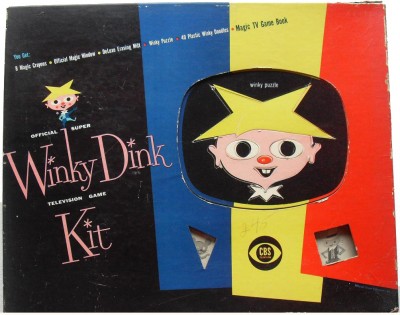
- Stephen Heller at Print Magazine reminisces about Winky Dink. Check it out.
Somewhere I have one of these original kits. The envelope it’s in is deteriorating; they used such poor quality paper to pack it in.
Commentary 21 Apr 2011 06:31 am
Loose Pieces
 - In days past John Kricfalusi spent quite a bit of time on his site giving some great instructions, via his completed animation art, as to how to properly do different phases of the process. You can start with this ode to Bobe Cannon where images are all he needs to offer in a breakdown of Chuck Jones’s Hold the Lion. Then there’s this great piece on the BG painting technique of Art Lozzi. Part 1, Part 2. There are plenty of other great pieces of this sort, if you haven’t already seen, by just scrolling about.
- In days past John Kricfalusi spent quite a bit of time on his site giving some great instructions, via his completed animation art, as to how to properly do different phases of the process. You can start with this ode to Bobe Cannon where images are all he needs to offer in a breakdown of Chuck Jones’s Hold the Lion. Then there’s this great piece on the BG painting technique of Art Lozzi. Part 1, Part 2. There are plenty of other great pieces of this sort, if you haven’t already seen, by just scrolling about.
Recently, he has posted an excellent piece on working storyboards-to-layouts and how to get the most out of both. The layout poses remind me of the working style of Chuck Jones, giving plenty of juicy poses for the animator to follow. Kricfalusi’s purpose, however, isn’t for the animator in the studio but for the animator overseas. As it turns out, I think it’s probably appropriate for both. It’s well worth reading and studying this art from a past Ren & Stimpy episode. Even if you think you’re beyond these stages. I suggest you take a look. Even if you have nothing to learn, it may remind you of how to do better work on these two phases of an animated film. You can find Part 1 and Part 2 at the links. There are another couple of Parts adding more layout drawings to his thesis, but those first two parts are the keys.
.
 On Wednesday, April 27th and Monday, May 1, Oscar nominated animator, Joyce Borenstein, will be giving guided tours through an exhibition of her father’s paintings at Yeshiva University Museum. Sam Borenstein (1908-1969) is considered a master of post-war expressionism in Canada. Joyce’s Oscar-nominated short animated documentary about her father will also be screened.
On Wednesday, April 27th and Monday, May 1, Oscar nominated animator, Joyce Borenstein, will be giving guided tours through an exhibition of her father’s paintings at Yeshiva University Museum. Sam Borenstein (1908-1969) is considered a master of post-war expressionism in Canada. Joyce’s Oscar-nominated short animated documentary about her father will also be screened.
Yeshiva University Museum’s SELZ GALLERY is located at 15 West 16th Street, NYC. The exhibition continues through to May 8, 2011.
.
- I saw Rio last week and had mixed feelings. A real three star event. The visuals are lovely to look at, beautifully colored and crafted. The character design was good, though I couldn’t get over the fact that the leading male human looked so much like animation director Ray Kosarin. I saw no cliches in the character design or animation and find that rare from American animation. The voices are excellent. I particularly liked Jesse Eisenberg as the lead character, Blu, and Jemaine Clement as the villainous owl.
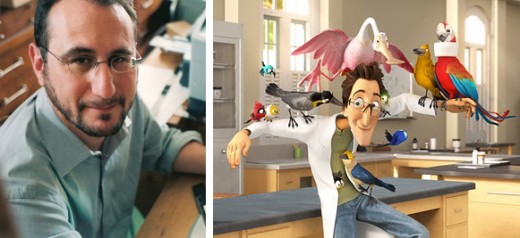
The real Ray?
The problem with the film came with the writing. The plot overcomplicates with a very 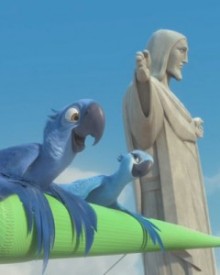 simple and obvious story. There are too many characters and too many of them are introduced late in the game. The film keeps jumping from one plot direction to another to another and back again, but there is no real tension created anywhere in the film. This is too bad since the film has so much going for it.
simple and obvious story. There are too many characters and too many of them are introduced late in the game. The film keeps jumping from one plot direction to another to another and back again, but there is no real tension created anywhere in the film. This is too bad since the film has so much going for it.
By the way the 3D is good. I have to admit my eyes watered as usual with these glasses, but the graying effect wasn’t as enormous as it was on other films – particularly Tangled. There is one incredible 3D shot where the camera flies around the statue, Christ the Redeemer, and an arm stretches wildly into the audience. Seeing some stills of this shot shows that the effect is completely nothing in 2D.
Commentary 16 Apr 2011 06:54 am
More about Sidney
- I don’t really feel as though I’d hit the mark in my post about Sidney Lumet. The man made such an impact on my life. I wrote about the different films that I worked on for him, but don’t feel as though I really said much about him. A lot of thoughts and memories have gone through my head in the last couple of days since that post. I thought with this one, I’d give some disconnected memories of things that happened or were spoken during the process of making titles.
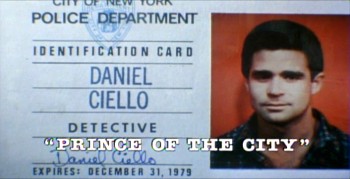 There was always an initial screening of the rough cut in a small screening room. People generally seem to sit two seats away from each other. Unless you came with someone, you didn’t sit next to anyone. At the Prince of the City screening there were no titles on or during the film, no music, and lots of markings on the print. It felt exciting. I came with Phillip Schopper, who I was bringing onto the project, and we sat alongside each other. Silent. When we met with Sidney immediately after, he told us the major problem he had with the film, and it was the one I’d seen: the film was confusing, at that time. You couldn’t ID many of the characters and you didn’t remember which side they were on – good or bad. Sidney asked for us to do IDs throughout the film. We did something pathetically simple in making the good guys color and the bad guys B&W, but it wasn’t obvious. I have to say that our work really tied the film together and made the characters more clear.
There was always an initial screening of the rough cut in a small screening room. People generally seem to sit two seats away from each other. Unless you came with someone, you didn’t sit next to anyone. At the Prince of the City screening there were no titles on or during the film, no music, and lots of markings on the print. It felt exciting. I came with Phillip Schopper, who I was bringing onto the project, and we sat alongside each other. Silent. When we met with Sidney immediately after, he told us the major problem he had with the film, and it was the one I’d seen: the film was confusing, at that time. You couldn’t ID many of the characters and you didn’t remember which side they were on – good or bad. Sidney asked for us to do IDs throughout the film. We did something pathetically simple in making the good guys color and the bad guys B&W, but it wasn’t obvious. I have to say that our work really tied the film together and made the characters more clear.
The initial screening for Garbo Talks was a bit more peculiar. I sat down and a woman sat next to me; I sort of recognized her. We said hello when she sat down. Somewhere midway during the film I realized who the woman was – Betty Comden, that half of the Comden & Green writing team. I realized she was playing the part of the older Greta Garbo in the film. It was brilliant casting, but you could say that about all of Sidney’s movies.
When I left the screening room there was a tense meeting going on with four people. I caught Sidney’s eye and waved goodbye. Going down in the elevator Burtt Harris, the producer, rushed in as the doors were closing. He asked what I thought of the film. Before I answered he said it wasn’t working, and Elliott Kastner and MGM weren’t very happy. A rough conversation in an elevator.
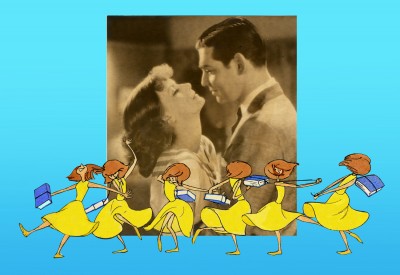
The next day, Sidney asked what I thought of the film, I said that I felt we didn’t know enough of the back story of the Ann Bancroft character in the film. I suggested that I try to offer this in the opening credit sequence. Sidney loved the idea. He just made me promise that it wouldn’t feel like the credits to “I Love Lucy” or “I Dream of Jeannie.”
During the mix, we were talking about the music for Garbo Talks when we slipped off into discussing the music for some of Sidney’s other films. I told him that the music by Richard Rodney Bennet for Murder on the Orient Express was one of the most brilliant film scores ever done. Sidney hesitated in responding finally saying he didn’t get it at first, and it took a while for him to appreciate the music for that film. Sidney wasn’t always perfect in selecting a composer for his films, although I do think that Johnny Mandel was a great choice for him on Deathtrap and The Verdict (or any film, actually).
Bob James had scored Garbo Talks. (He is an eminent jazz pianist, whose most famous piece is probably the theme to the tv show, Taxi.) Bob and I had to work together very closely. He wrote the score to the animatic I’d given him and would build the rest of the film’s score from that. He hit many of the actions in that opening title, and Tissa David‘s animation hit them all. There was a very tight sync between music and title animation.
The preview screening was held on Long Island. I drove there and met the group of Sidney, editors and MGM execs, including Elliott Kastner. He was the leading producer on the film. They weren’t happy at the end of the screening, and I was sure my titles were going to go. It took a week to hear that the titles were staying, but the score by Bob James was dropped. The composer took the hit, unfairly. A new score was being written by Cy Coleman. All that tight sync work!
Coleman wrote a lovely melody for the film, but just swept across the animation not hitting any points in particular. It’s taken me a long time, but I’ve come to like the music he wrote. Tissa still won’t watch it with the newer music.
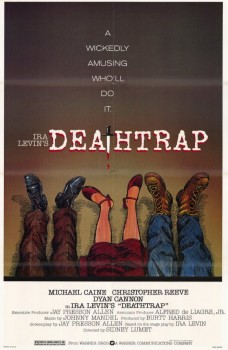 Before Deathtrap, Sidney phoned me to say that his daughter, Jenny, and her boyfriend were free for the summer and both were artistically inclined. He wondered if there were anything I could offer them in the way of a summer job. Basically, I was being offered their services in exchange for the next title job. This was the real movie business, one hand washes the other. Why not?
Before Deathtrap, Sidney phoned me to say that his daughter, Jenny, and her boyfriend were free for the summer and both were artistically inclined. He wondered if there were anything I could offer them in the way of a summer job. Basically, I was being offered their services in exchange for the next title job. This was the real movie business, one hand washes the other. Why not?
I did have work and could keep them busy in my studio. It turned out to be an entertaining summer (more for my production supervisor at the time, Steve Parton, than it was for me). Jenny and friend both did a good job for the work they were given. I had fun with Deathtrap. Jenny went on to writing screenplays earning lots of awards for her first film, Rachel Getting Married.
I remember, one day, walking a couple of city blocks with Sidney. He told me he’d just seen the recent Indiana Jones movie. He commented that he didn’t think there was a scene longer than 3 seconds and felt that something seriously bad was happening to movies. He was on his way to see a rough cut of Wall Street and was curious to see what Oliver Stone had done but said it was a tough subject.
There was another time when Sidney couldn’t leave the editing room. He was waiting for a call from Barbra Streisand. She was about to direct her first film, Yentl, and she wanted advice from Sidney. During my meeting with him, the call came through, and I scheduled another time. Afterwards he told me that she’ll do a great job; she did.
Sidney was great to work with. He had this interesting way of telling me exactly how many frames (3 or 5 or some such number) he wanted something on the screen. This happened quite a few times. I didn’t follow what he said, exactly, but I knew from the conversation just what he was looking for; he made it easy for me to give it.
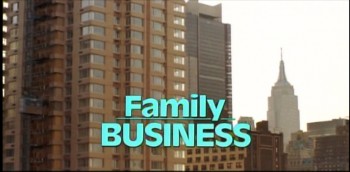 I was always curious about Sidney’s work with editors. It seemed that they worked with him for one or two films and then he quickly moved to someone else. Oftentimes, an Assistant Editor on one film would graduate to the Editor on the next. I found it curious on one movie to be working with John Fitzsimmons editing, and on the next film it was Andrew Mondshein. Andy continued on through another couple of films, and John Fitzsimmons came back to be his Sound Editor.
I was always curious about Sidney’s work with editors. It seemed that they worked with him for one or two films and then he quickly moved to someone else. Oftentimes, an Assistant Editor on one film would graduate to the Editor on the next. I found it curious on one movie to be working with John Fitzsimmons editing, and on the next film it was Andrew Mondshein. Andy continued on through another couple of films, and John Fitzsimmons came back to be his Sound Editor.
The last job we did together was Family Business. I was asked to work with the Greenbergs who were doing all the effects, and Sidney also wanted them to do the opticals for the credits. Fine. But there were problems, and the job was done over many times. The Greenbergs were the most expensive optical house in NY at the time. I got my fee, and they got theirs. Needless to say, they made more money than I.
When it came time for the titles for the next film I received a call from an editor I didn’t know (Richard Cirincione). He said that Sidney asked me to do the titles for the new film, Q & A, but it had to be less expensive. I agreed and said that if they’d allow me to do my opticals at a house of my choosing I could keep the costs down, otherwise I had no control. 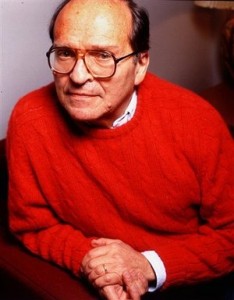 (I had done this with Running on Empty and brought the titles in for a very low budget. They were also beautifully handled.) I made sure the editor understood that I certainly wanted to do the film, even if it was only a break-even job for me.
(I had done this with Running on Empty and brought the titles in for a very low budget. They were also beautifully handled.) I made sure the editor understood that I certainly wanted to do the film, even if it was only a break-even job for me.
I didn’t hear from the editor again. I’m sure I was caught up in some inner political thing. I knew it was going to happen.
The last time I met Sidney was at an Academy salute to the brilliant editor Dede Allen. There were a number of greats there, Sidney, Tony Walton and Arthur Penn among them. Sidney first saw me in the lavatory where he gave me a big hello. We talked a bit on leaving and entering the party, but nothing special was said. It was just nice to be remembered and greeted so well. I miss that relationship, and I’ll miss Sidney.
.
A.O. Scott in the NYTimes wrote a fine piece about the urgency of Sidney’s films.
Commentary &Independent Animation 13 Apr 2011 03:37 am
Sidney and Emily
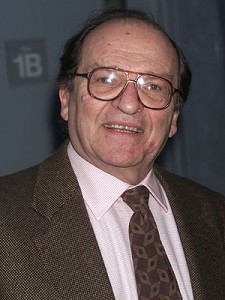 - I was a bit distraught at hearing of the death of director, Sidney Lumet. His film style is so evidently personal that you can tell his direction within the first few minutes of watching any scenes. There have been so many wonderful obituaries for the man, that I won’t attempt one. (Here‘s a good one. This is the NYTimes obit.)
- I was a bit distraught at hearing of the death of director, Sidney Lumet. His film style is so evidently personal that you can tell his direction within the first few minutes of watching any scenes. There have been so many wonderful obituaries for the man, that I won’t attempt one. (Here‘s a good one. This is the NYTimes obit.)
I did work with him several times and felt honored to have done so.
Prince of the City was the first shot at movie titles I got to do. Art Director, Tony Walton, brought me onto the film. They not only needed an opening title and credits but they wanted some inner film ID’s for the characters. It became a large job and one that still stands out as exciting. My friend Phillip Schopper became a strong second helping to get this film done. Together, we did it all ourselves. Everything from putting makeup on the actors’ faces to forging real ID cards to photographing it with unusual lighting under an Oxberry.
Deathtrap was a very different model. For the opening credits he asked for very large type filling the screen. He also wanted an old fashioned typewriter type. Nothing really existed that worked for those demands, so I had to develop my own typeface for it. I’m not particularly happy with the end results.
I had to rush some end credits for a preview screening. Sidney asked me to just make a scroll over a blood red color. Unfortunately, he got to like that and wouldn’t allow me to try something more inventive. However, with only three days before the film was to go to the neg cutter, I did something wild. I dripped blobs and splashes of the blood red color behind the white credits until the screen had turned red. It took a full 36 hours of work and a rush at the lab to get them back. I rushed to the editor to cut them in the film and we screened it for Sidney. Those are the end titles, and I love them.
 Garbo Talks was a wonderful animation job telling the principal characters back story (in music only) up to the start of the film. It was fun researching Garbo’s life and films and photos.
Garbo Talks was a wonderful animation job telling the principal characters back story (in music only) up to the start of the film. It was fun researching Garbo’s life and films and photos.
Running On Empty was a wonderful film. I animated a sequence of animated roads for a test title. We decided to do it live action just focusing on the dashed lines of some local roads upstate NY. The movement wa very quick so a dashed line might just take one frame of film. The editor was bothered by the fact that every third dash was painted over black. I suggested he just cut out those frames, just as we might do in animation. He did and it worked beautifully. I loved this film. If you have the chance to see it, please do. River Phoenix and Martha Plimpton were exceptional as the adolescent heroes of the story. I sat in on several days of the mix of this film and had a lot of time to chat with Sidney and mixer Tom Fleischman.
On Family Business, Sidney introduced me to Sean Connery. Sean was wearing some ostentacious jacket and for some reason, right off the bat, he apologized to me for it. He said it had been given to him by the King of Arabia. Then he immediately qualified that so that I knew there was nothing sexual in the gift. Needless, to say it was a strange conversation.
The Family Business titles were designed by me and executed by R. Greenberg’s studio. It was a major problem for the opening credits. The camera does a 360° pan on a rooftop. All the colors of the twilight sky, all the buildings, all the city acted as the backdrop or these credits. Sidney wanted only type above this backdrop (I couldn’t put the credits within boxes). The white letters would be washed out against the white of the sky; the black credits were not there when we hit black. As a matter of fact, the credits seemed to wash into almost every color we tried. It took about six go-arounds before we hit on something that worked. I’m glad I had the large team at Greenberg’s to pull it through.
I loved working with Sidney, and I’m sad that he’s not there anymore. I don’t need to talk of work with him. I just liked knowing he was there.
.
 - I’m sure you’re curious as to what connection there is between Emily Hubley and Sidney Lumet. Actually, I first met Sidney at a party given by John & Faith Hubley. It was a “hello” and a “I’m your biggest fan” kind of embarrasing meeting, that I’m sure Sidney quickly forgot.
- I’m sure you’re curious as to what connection there is between Emily Hubley and Sidney Lumet. Actually, I first met Sidney at a party given by John & Faith Hubley. It was a “hello” and a “I’m your biggest fan” kind of embarrasing meeting, that I’m sure Sidney quickly forgot.
On Monday evening I went to the Big Screen Project event in midtown Manhattan. There was a show of Emily Hubley‘s work. It was good to see some of her classics again. “The Tower” (1986) was an early one; I can remember Emily and Georgia working on it. Two of my favorites are “Blake Ball” (1989) and “Delivery Man” (1982). The story in both films is exciting and even inspirational. I’m sorry “Delivery Man” wasn’t screened.
The weather was wonderful, so it was nice sitting outdoors in the early evening. It gave me the chance to catch up with some old friends. Emily and Will Rosenthal are always great to talk to. Debbie Solomon, Biljana Labovic, Meryl Rosner, Adrian Urquidez, Maria Scavullo, and Janet Benn were all there. There were plenty of others, but those were the above: Emily with Jaime Ekkenspeople I was able to chat with.
There was a technical problem with the sound. They’d normally hand out small radio receivers with earphones, which allow you to hear the tracks in excellent stereo. Unfortunately, something technical happened and the didn’t hand out the receivers. No sound. It was a curious way to watch Emily’s films. The imagery is so evocative. However, we really only got half the films.
Hopefully, they’ll have corrected this problem before screening any more of the animation shorts.

The three closest, with backs to us are: (in red) Biljana Labovic,
(in black) Meryl Rosner, (in pinstripes) Janet Benn.
Tonight Jeff Scher will have his films screened. It’d be tragic if the wonderful Shay Lynch scores weren’t heard. I hope they’ll have the sound system worked out.
Jaime Ekkens organized and hosted the event for Big Screen Project.
Big Screen Project Sixth Ave. between 29th & 30th St.
Enter through the Food Parc, and go all the way back to the courtyard.
7-8pm
.
More of Milt Kahl‘s Llama drawings will return tomorrow.
Commentary 02 Apr 2011 08:23 am
Dilworth and 100 Features and Thursday
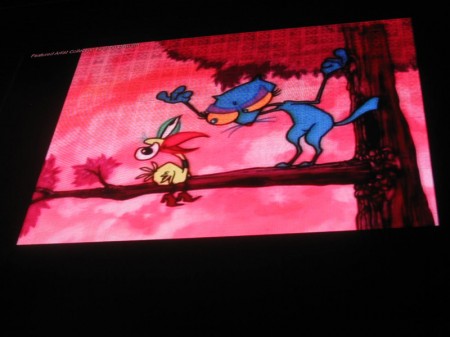
The Dirty Birdy
- Last night was John Dilworth night at the Big Screen Project. As you can see from the above photo, this is a 30 foot video screen plunked mid block off Sixth Avenue between 29th & 30th Streets. John invited lots of friends for the two screenings. Unfortunately, the weather didn’t cooperate, and we had a cool, windy, rainy night.
The event, however, wasn’t spoiled because there was an enclosure into the building, and we were able to look out at the monitor. They hand out closed circuit radios (with earplugs – you take home with you) to hear the sound track (in stereo) while watching from the warm comfort of the building. It’s a food court so there’s plenty of food to purchase or you can have a drink, since the area we watched from was a pub. It made for a fun and interesting experience.
The program was well organized and coordinated by Jaime Ekkens for Big Screen Project.
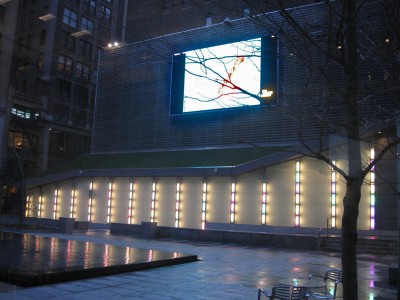
Looking out to the screen from the bar.

The films absolutely seemed to glow on the crystal clear monitor.
There are plenty of other animators up this April to showcase their films. Go here to see the April schedule. Emily Hubley‘s films are up next on April 11th.
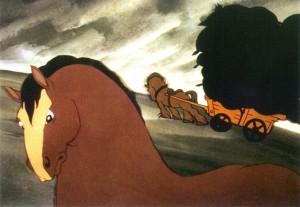 - This past week I received a book in the mail, 100 Animated Feature Films. When the book arrived, I was so taken by the cover design (an image from Lotte Reiniger‘s Prince Achmed, the first full length animated feature) that I immediately opened and started into the book.
- This past week I received a book in the mail, 100 Animated Feature Films. When the book arrived, I was so taken by the cover design (an image from Lotte Reiniger‘s Prince Achmed, the first full length animated feature) that I immediately opened and started into the book.
I was curious about the taste of the author, Andrew Osmond. Would it be another list that would be more studio oriented or more, perhaps, something a bit more siding with the Independent studio. Would his taste run more to the current films or the Golden Age? He’s written a number of articles about Satoshi Kon and Miyazaki for Britain’s The Guardian, so one has a good idea of his preferences.
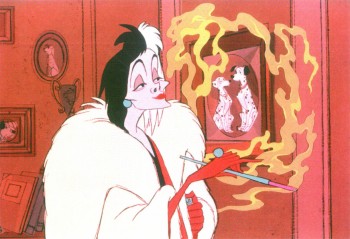 In fact, I found myself pretty well pleased with a lot of the listings. It’s a bit more Anime than I would have gone toward, but I can easily understand the choice. However, there are many expected and deserved choices within the book. I’m glad to see Reininger’s Prince Achmed listed, as, of course, is Snow White. Other Disney titles include: Pinocchio, Bambi, Fantasia, Dumbo, Beauty and the Beast. There are also a bunch of Pixar films, some of which are: only one Toy Story (the original), The Incredibles, Monsters Inc., Finding Nemo and Up.
In fact, I found myself pretty well pleased with a lot of the listings. It’s a bit more Anime than I would have gone toward, but I can easily understand the choice. However, there are many expected and deserved choices within the book. I’m glad to see Reininger’s Prince Achmed listed, as, of course, is Snow White. Other Disney titles include: Pinocchio, Bambi, Fantasia, Dumbo, Beauty and the Beast. There are also a bunch of Pixar films, some of which are: only one Toy Story (the original), The Incredibles, Monsters Inc., Finding Nemo and Up.
Surprises were finding some titles such as:
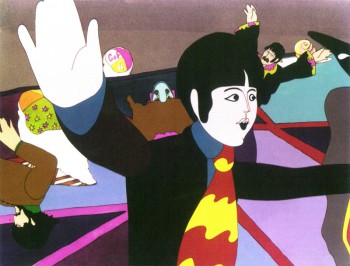 The Thief and the Cobbler. The final film version of Richard Williams’ feature, on the market, is horrible. The one in the works for 30 years was visually stunning. This is listed here for what it might have been.
The Thief and the Cobbler. The final film version of Richard Williams’ feature, on the market, is horrible. The one in the works for 30 years was visually stunning. This is listed here for what it might have been.Sita Sings the Blues. This is the only Flash animated feature included. A truly solo work, Nina Paley, created a thinking film with a lot of glorious sections.
Batman Beyond: Return of the Joker. This is a spin-off the television series, and doesn’t have the weight that any title in such a book deserves.
A Scanner Darkly. I might have chosen Waking Life over this title, but I suppose this has a more coherent story. Regardless, I’m glad to see one of Richard Linklater’s films included.
Avatar. Jim Cameron fought to make sure people didn’t consider this animation. I guess, he’s lost. Animation or Live Action, it’s not a very good film.
Both of Sylvain Chomet‘s films: The Illusionist and The Triplettes of Belleville. They both belong here.
Surprises not found in the book:
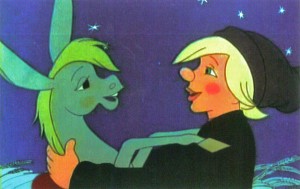 Gulliver’s Travels. Osmond includes Hoppity Goes to Town, but leaves Gulliver out. Excuse me, but Batman Beyond OVER the beautiful Fleischer gem? Something doesn’t smell so good.
Gulliver’s Travels. Osmond includes Hoppity Goes to Town, but leaves Gulliver out. Excuse me, but Batman Beyond OVER the beautiful Fleischer gem? Something doesn’t smell so good.Ratatouille. This is certainly one of the best of Pixar’s films. To include Finding Nemo and not this excellent feature by Brad Bird is just crazy. I suppose he had Bird’s The Incredibles and he wanted to write about Andrew Stanton.
And if you’re going to include films for the sake of the director, wouldn’t Chuck Jones‘ only feature, The Phantom Tollbooth, be included?
Neither UPA feature: Magoo’s 1001 Arabian Nights and Gay Purr-ee were both left out of the book. Given the heavy number of Japanese features, I would have found one to keep out to include a UPA example.
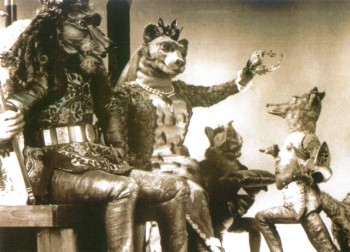 However despite any gripes, I have to say the book is solidly written and intelligently put together with a lot of thought going into the choices. It’s expected I’d have opposing thoughts on the titles included, but I admit to being intelligently challenged by the author. Andrew Osmond did a fine job, and the book is graphically attractive. I do wish, though, that the type were a bit larger. It looks like it’s about 8pt. and it’s too small for my aging eyes. The book was published by BFI Screen Guides.
However despite any gripes, I have to say the book is solidly written and intelligently put together with a lot of thought going into the choices. It’s expected I’d have opposing thoughts on the titles included, but I admit to being intelligently challenged by the author. Andrew Osmond did a fine job, and the book is graphically attractive. I do wish, though, that the type were a bit larger. It looks like it’s about 8pt. and it’s too small for my aging eyes. The book was published by BFI Screen Guides.
The images above can be found in the book.
1) Animal Farm
2) 101 Dalmatians
3) The Yellow Submarine
4) Ivan and His Magic Pony
5) The Tale of the Fox
I saw this film on line last Tuesday. Cartoon Brew posted it on Wedneday. If you saw it there, I’m pleased; if not this is for you. Matthias Hoegg‘s BAFTA nominated short, Thursday, can be seen online here. It’s an excellent film with a lot of the character necessarily developed through the animation. At the same website, there’s also an interview with Matthias about the making of the short. Take the 7 minutes to watch the film. A good use of cgi and 2D.
He’s represented by Beakus. Their site also showcases a number of his films.
Commentary 28 Mar 2011 07:03 am
Lantz and me
- Like many others, reading the Roger Armstrong reminiscence on Mike Barrier‘s site really got me into the Walter Lantz mood.
 I first went back to Mike’s book, The Hollywood Cartoon, and read what info he had about Lantz. After a bit of reading there, I went to look at some of the old Woody Woodpecker shows – I have that collection from Columbia House that came out years ago which includes about three half hour shows per DVD, 10 DVDs, and some beautiful prints.
I first went back to Mike’s book, The Hollywood Cartoon, and read what info he had about Lantz. After a bit of reading there, I went to look at some of the old Woody Woodpecker shows – I have that collection from Columbia House that came out years ago which includes about three half hour shows per DVD, 10 DVDs, and some beautiful prints.
Then I reread one of my all time favorite animation books, The Walter Lantz Story by Joe Adamson. This isn’t a terribly large book, but it sure is packed with a lot of first-rate information.
As an owner of my own animation company I get a real charge in reading about the ups and downs Lantz had to go through, financially, to keep his company afloat. In one chapter, Universal dropped him, and he rebuilt, financing a couple of films with the help of a few animators. Then he went back to Univeral and sold the films to them with a brand new deal. It took enormous entrepreneurial strength believing in what he did and going forward with everything on the line.
It’s a great book, and Joe Adamson should be proud of the effort. I also encourage you all to read it. (If only there were a similar book about Paul Terry.)
I got to meet Lantz a couple of times in his late years. One was at Grim Natwick’s 100th birthday. Too bad Walter didn’t sit for the group photo; it would’ve added something to the collected group of animation veterans.

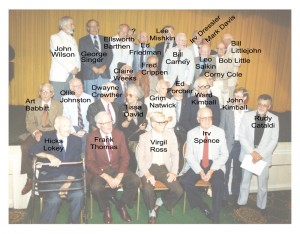
The group photo with ID’s alongside this picture.
(Click to enlarge.)
Another event in LA was the Walter Lantz Conference on Animation in which a number of speakers spoke and films were screened. Lantz was everywhere in those few days. It was great.
However, my most memorable meeting came thanks to John Canemaker. John had interviewed and met with Lantz several times during a group of meetings Walter and Gracie were having in New York in the 70s. There was, if I remember correctly, a special screening of their films at which they would talk. Since I was going there, John asked if I wanted to meet up with him and ride to the event with Walter and Gracie in their limousine. It was a treat to meet them one-on-one and to have a chance to share a few words. I have to say he was one of the most kind people I’ve run across, who gave me plenty of chance to talk. It was one of those standout moments in my life.
To complete this post, I’m going to repeat an older piece about one of my favorite Lantz/Woody Woodpecker cartoons, Ace In The Hole.
 - Back in the day, when I was just a teenager, there was very little in the way of media, as there is today. If you were desperate to become an animator, there weren’t many directions to turn. You had what was on the four or five tv channels that existed and there was the library.
- Back in the day, when I was just a teenager, there was very little in the way of media, as there is today. If you were desperate to become an animator, there weren’t many directions to turn. You had what was on the four or five tv channels that existed and there was the library.
TV offered the Walt Disney show, which two out of four Wednesdays (later Sundays) each month, they’d touch on “Fantasyland”, and 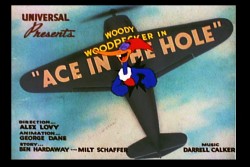 you could watch some Disney cartoons – usually Donald and Chip & Dale, or there was the Woody Woodpecker show, during which Walter Lantz would talk for four or five minutes about some aspect of animation.
you could watch some Disney cartoons – usually Donald and Chip & Dale, or there was the Woody Woodpecker show, during which Walter Lantz would talk for four or five minutes about some aspect of animation.
For all those other hours of the day when you wanted animation you had to make do with what you could create for yourself.
At the age of 11, I took a part time job for a pharmacist delivering drugs to his clientele.
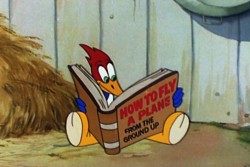 I lived off the tips that were offered, and I saved my money until I had enough to buy a used movie camera. The trek into downtown Manhattan was a big one for an eleven year old child, but I loved it. I went by myself to Peerless camera store near Grand Central Station. (It later merged with Willoughby to become Peerless-Willoughby; then it went back to just being Willoughby.)
I lived off the tips that were offered, and I saved my money until I had enough to buy a used movie camera. The trek into downtown Manhattan was a big one for an eleven year old child, but I loved it. I went by myself to Peerless camera store near Grand Central Station. (It later merged with Willoughby to become Peerless-Willoughby; then it went back to just being Willoughby.)
That store, I quickly learned had a large
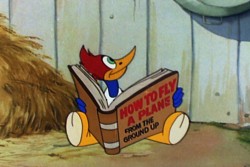 section devoted to films for the 8mm crowd. Lots of Laurel and Hardy, Our Gang and Woody Woodpecker cartoons. Once I had the camera, I saved for a cheap projector and eventually bought some 8mm cartoons.
section devoted to films for the 8mm crowd. Lots of Laurel and Hardy, Our Gang and Woody Woodpecker cartoons. Once I had the camera, I saved for a cheap projector and eventually bought some 8mm cartoons.
Independence. Now, I didn’t have to wait to see them on TV, I could project them myself whenever I wanted. Even better, I jiggered the projector to maneuver the framing device which allowed me to see one frame of the film
 at a time, so that I could advance the frames one at a time. I could study animation.
at a time, so that I could advance the frames one at a time. I could study animation.
I know, I know. I’m describing the stone ages. Today all you have to do is get the DVD (which is incredibly cheap compared to the cost of those old 8mm films) and watch it one frame at a time or any other way you want. And every film is available. If you don’t have it just join Netflix and rent it. Your library is always open and growing.

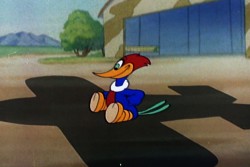
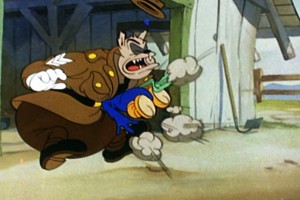 Yes, Peerless had an large 8mm film division, so you could buy the latest Castle film edition of some Woody Woodpecker cartoon, or you could find many of Ub Iwerks’ films. I had a collection of these. Ub Iwerks was my guy. Everything I’d read about him (in the few books available) got me excited about animation. Actually, Jack and the Beanstalk and Sinbad the Sailor were the first films I’d bought and watch endlessly over and over frame by frame.
Yes, Peerless had an large 8mm film division, so you could buy the latest Castle film edition of some Woody Woodpecker cartoon, or you could find many of Ub Iwerks’ films. I had a collection of these. Ub Iwerks was my guy. Everything I’d read about him (in the few books available) got me excited about animation. Actually, Jack and the Beanstalk and Sinbad the Sailor were the first films I’d bought and watch endlessly over and over frame by frame.
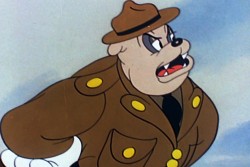 In short time, I knew every frame of Jack and the Beanstalk backwards and forwards. I didn’t realize that it was Grim Natwick who had animated (and directed the animation) on a good part of the film. Meeting Natwick years later, I think I surprised him by saying as much. He just moved on to another subject, appropriately enough.
In short time, I knew every frame of Jack and the Beanstalk backwards and forwards. I didn’t realize that it was Grim Natwick who had animated (and directed the animation) on a good part of the film. Meeting Natwick years later, I think I surprised him by saying as much. He just moved on to another subject, appropriately enough.
In some very real way, I learned animation from that film and several others that I
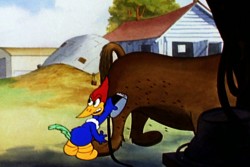 bought in those primative years of my career. Before I knew principles of drawing, I’d been able to figure out principles of animation. I’d had the Preston Blair book, and I had the Tips on Animation from the Disneyland Corner. I just measured what they said about basic rules and watched – frame by frame – how these rules were executed by the Iwerks’ animators. The rest was up to me to figure out, and I was able to do that.
bought in those primative years of my career. Before I knew principles of drawing, I’d been able to figure out principles of animation. I’d had the Preston Blair book, and I had the Tips on Animation from the Disneyland Corner. I just measured what they said about basic rules and watched – frame by frame – how these rules were executed by the Iwerks’ animators. The rest was up to me to figure out, and I was able to do that.
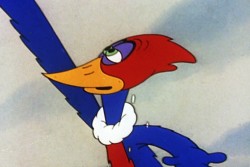
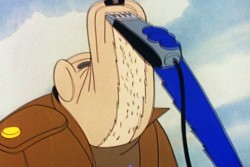
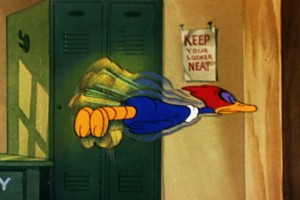 Eventually I bought a Woody Woodpecker cartoon. I was reluctant because so many of them were the very limited films done in the early 60′s – Ma and Pa Beary etc. It took a while to figure out that Ace in the Hole was a wartime movie and the animation would be a bit better. It was also the Woody that I liked – just a bit crazy. So I sprang for it and swallowed that film’s every frame for years.
Eventually I bought a Woody Woodpecker cartoon. I was reluctant because so many of them were the very limited films done in the early 60′s – Ma and Pa Beary etc. It took a while to figure out that Ace in the Hole was a wartime movie and the animation would be a bit better. It was also the Woody that I liked – just a bit crazy. So I sprang for it and swallowed that film’s every frame for years.
 I’m not sure who George Dane is, (he seems to have spent years at Lantz before working years at H&B and Filmation) but I studied and analyzed his animation on this film closely and carefully.
I’m not sure who George Dane is, (he seems to have spent years at Lantz before working years at H&B and Filmation) but I studied and analyzed his animation on this film closely and carefully.
The work reminded me of some of the animation done for Columbia in the early 40′s. It had that same mushiness while at the same time not breaking any of the rules. Regardless, he knew what he was doing, and I had a lot to learn from him. And I did.
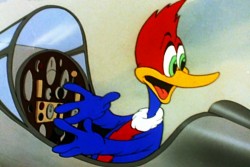

 Things keep changing, media keeps growing. I’m glad I had to fight to get to see any of those old 8mm shorts back in the early years. When I bought my first vhs copy of a Disney feature, it took a while to grasp the fact that I could see every frame of it whenever I wanted. In bygone years, I could only see the rejects that TV didn’t want. I wanted to study Tytla and Thomas and Natwick and Kahl. Instead, I studied George Dane. And you know what, it was pretty damn OK. I
Things keep changing, media keeps growing. I’m glad I had to fight to get to see any of those old 8mm shorts back in the early years. When I bought my first vhs copy of a Disney feature, it took a while to grasp the fact that I could see every frame of it whenever I wanted. In bygone years, I could only see the rejects that TV didn’t want. I wanted to study Tytla and Thomas and Natwick and Kahl. Instead, I studied George Dane. And you know what, it was pretty damn OK. I  learned enough that I knew a lot when I started in the business. I just jumped in and was animating for John Hubley within days of getting that first job. (It helps that it was an open studio like Hubley’s where the individual artist could do anything, as long as he kept his head above water. In most studios there’s a rigidity that keeps you in your classified job.) In fact by then, I was more interested in Art Direction and Direction than I was in animation, but that’s another post.
learned enough that I knew a lot when I started in the business. I just jumped in and was animating for John Hubley within days of getting that first job. (It helps that it was an open studio like Hubley’s where the individual artist could do anything, as long as he kept his head above water. In most studios there’s a rigidity that keeps you in your classified job.) In fact by then, I was more interested in Art Direction and Direction than I was in animation, but that’s another post.
If you want to learn from the masters, just pop in a DVD and watch it frame-by-frame. If you don’t get a charge out of it, you might begin to wonder if you’re really in the right business. After all these years, I still get the thrill, and I imagine I always will – even from watching Ace in the Hole AGAIN.
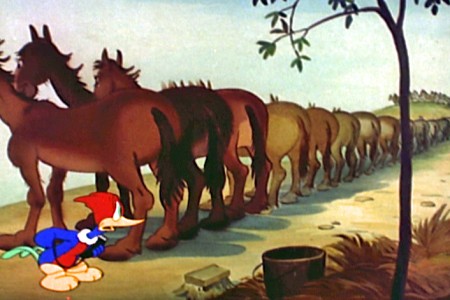
Commentary 26 Mar 2011 07:57 am
bits and pieces and screenings
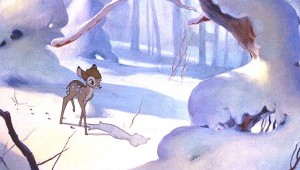 - Before getting into the info section of this post, let me talk about something that’s been bothering me from Disney on TV. Because Disney owns ABC, all their VOD shows have commercials for upcoming DVDs and movies in theaters.
- Before getting into the info section of this post, let me talk about something that’s been bothering me from Disney on TV. Because Disney owns ABC, all their VOD shows have commercials for upcoming DVDs and movies in theaters.
Currently, an ad for Bambi runs at every commercial break, as does one for Mars Needs Moms (or whatever that film is called). The Bambi ads make me feel good watching some of the iconic scenes over and over again: autumn leaves blowing, Bambi’s first steps, Bambi on ice . . . a bunch of them. However, the music is downright annoying. Instead of using music from the film, they’ve hired someone to write a bed of Musak in the usual pop style to cover anything that’s happening on sreen.
Here’s a film that has brilliant music, and it’s all out the door, replaced by audible nothing, the musical equivalent of watered-down milk. It’s just another fine example of the little respect the Disney people really have for their merchandise. It’s like playing an ad for The Wizard of Oz and not using any of the songs. I don’t know; I throw my hands in the air in frustration. At least they’re running ads, I suppose. But they treat Mars Needs Moms with more respect and play the hyper music from that film during its ad. No synth-pop composer has been called in to write a bed of nothing.
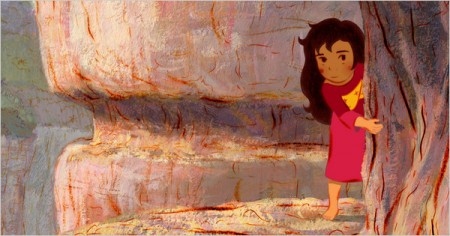
Mia and the Migoo
- The French animated feature. Mia and the Migoo, officially opened in New York, yesterday at the IFC Center, downtown. The film won as best animated feature at the 2009 European Film Awards.
The film has recieved mixed reviews from New York’s critics.
NYTimes said: “… trying to parse meaning in “Mia†is secondary to its main point, which is its look, created with 500,000 hand-drawn frames. That’s impressive in an age in which most mainstream animation is done with computers …”
The NY Daily News said: ” … though the animation can be transporting, its lack of lyricism is disappointing.”
The NY Post said: “France’s animated feature “Mia and the Migoo” is far too childish to intrigue adults yet too slow and dull for kids.”
You’ll find film times and schedule here.
- As it happens, the South Park guys, Trey Parker and Matt Stone, also opened their first Broadway musical yesterday. The reviews for The Book of Mormon were “Golden” as they might say. All four stars, all praise, all the time. This is obviously going to be the big hit of the year. Forget about it; it’ll be imposssible to buy a ticket.
NY Times, NY Post. NY Daily News, Wall St. Journal
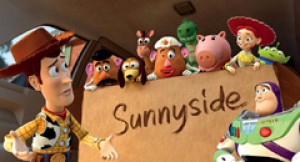 Ken Priebe sent the following notice:
Ken Priebe sent the following notice:
VanArts is hosting our Pixar Artists’ Masterclass with Andrew Gordon and Mike Venturini in New York City this summer, and also in Montreal (and Austin TX).
Registrations are now open for NYC, happening June 24th-25th, so we hope to have your friends, students and colleagues join us.
All information is available here.
- It’s become news when Maurice Sendak announces a new children’s book. According to the Wall Street Journal article, his latest book will be published in the Fall. It’s built from a character he developed for Sesame Street with Jim Henson. Apparently, the character, “Bumble Ardy” stuck in the author/illustrator’s mind, and now, at the age of 82, he’s developed it into a book. Unfortunately, no pictures of the character came with the article. However, here’s the original Sesame Street spot. Sendak has changed the boy into a pig.
______________________________
John Dillworth is having a BIG showing of his films at the new venue the Big Screen Project. All the information you need is posted above.
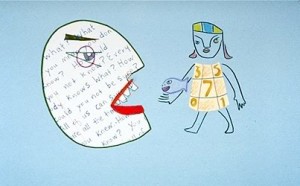 Additionally, Emily Hubley will be having a screening of her films at this site on April 11th. All the information for that screening can be found here.
Additionally, Emily Hubley will be having a screening of her films at this site on April 11th. All the information for that screening can be found here.
The films she’ll screen will include:
One Self: Fish/Girl
Enough
The Tower (made w Georgia Hubley)
Set Set Spike
Delivery Man
Octave
Blake Ball
Likewise there will be other screenings during the month of April. Go here to find out about Elliot Cowan, Nina Paley, Bill Plympton and Deborah Solomon‘s screenings.

